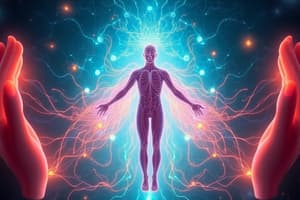Podcast
Questions and Answers
What is the primary function of the cerebellum?
What is the primary function of the cerebellum?
- Controls thinking and memory
- Coordinates muscle movements and maintains balance (correct)
- Regulates heart rate and blood pressure
- Transmits electrical impulses to muscles
Which part of the neuron integrates incoming signals?
Which part of the neuron integrates incoming signals?
- Axon terminals
- Dendrites
- Axon
- Cell body (correct)
What is resting membrane potential and its typical value?
What is resting membrane potential and its typical value?
- Unstable electrical potential, varies constantly
- Negative electrical potential, about -70 mV (correct)
- Positive electrical potential, about +70 mV
- Zero electrical potential, about 0 mV
What is the role of the sodium-potassium pump in a neuron?
What is the role of the sodium-potassium pump in a neuron?
Which ion has a higher concentration in the interstitial fluid compared to cytosol?
Which ion has a higher concentration in the interstitial fluid compared to cytosol?
Which of these structures connects the brain to the spinal cord?
Which of these structures connects the brain to the spinal cord?
What is primarily transported by the axon of a neuron?
What is primarily transported by the axon of a neuron?
Which characteristic is not typical of a neuron at rest?
Which characteristic is not typical of a neuron at rest?
What initiates the action potential in a neuron?
What initiates the action potential in a neuron?
During which phase do sodium ions (Na+) rush into the cell?
During which phase do sodium ions (Na+) rush into the cell?
What is the purpose of opening voltage-gated potassium channels during repolarization?
What is the purpose of opening voltage-gated potassium channels during repolarization?
What occurs during hyperpolarization?
What occurs during hyperpolarization?
What is the function of synaptic vesicles in the presynaptic neuron?
What is the function of synaptic vesicles in the presynaptic neuron?
Which structure separates the presynaptic and postsynaptic neurons?
Which structure separates the presynaptic and postsynaptic neurons?
What happens when the action potential reaches the axon terminals?
What happens when the action potential reaches the axon terminals?
Identify the term used for the neuron that receives the action potential across the synapse.
Identify the term used for the neuron that receives the action potential across the synapse.
Flashcards are hidden until you start studying
Study Notes
Nervous System Overview
- Central Nervous System (CNS) consists of the brain and spinal cord.
- Brain Structure
- Cerebrum: Responsible for thinking, memory, emotions, and voluntary movement.
- Cerebellum: Coordinates muscle movements, posture, and balance.
- Brainstem: Connects brain to spinal cord; regulates automatic functions such as breathing, heart rate, and blood pressure.
- Spinal Cord: Transmits messages between the brain and the body; coordinating reflexes.
Neuron Anatomy
- Neurons are specialized cells for transmitting information.
- Dendrites: Receive signals from other neurons and convey them to the cell body.
- Cell Body: Contains the nucleus and integrates incoming signals.
- Axon: Transmits electrical impulses away from the cell body.
- Axon Terminals: Release neurotransmitters to communicate with other cells.
Ion Concentration in Human Fluids
- Potassium (K+): High in cytosol (~140 mM), low in interstitial fluid (~4-5 mM).
- Sodium (Na+): Low in cytosol (~10-15 mM), high in interstitial fluid (~135-145 mM).
- Chloride (Cl-): Low in cytosol (~4-10 mM), high in interstitial fluid (~100-110 mM).
- Calcium (Ca2+): Very low in cytosol (~0.0001 mM), higher in interstitial fluid (~1-2 mM).
- Magnesium (Mg2+): Higher in cytosol (~0.5-1.0 mM), lower in interstitial fluid (~1-2 mM).
- Proteins: High concentration in cytosol, lower in interstitial fluid.
Resting Membrane Potential
- Neuron at rest has a negative potential of ~-70 mV.
- High Na+ concentration outside the cell and high K+ concentration inside.
- Maintained by sodium-potassium pump (3 Na+ out, 2 K+ in) using ATP.
Action Potential
- A rapid change in electrical potential allowing signal transmission.
- Depolarization:
- Triggered by a strong stimulus, reaching threshold potential (~-55 mV).
- Voltage-gated sodium channels open, Na+ floods in, raising membrane potential to ~+30 mV.
- Repolarization:
- Sodium channels close; potassium channels open.
- K+ exits, restoring negative charge inside the cell.
Hyperpolarization
- K+ channels stay open longer, causing a more negative membrane potential than resting state.
Synapse Structure
- Communication between neurons occurs across synapses.
- Presynaptic Neuron: Sends the action potential; contains presynaptic terminals with synaptic vesicles.
- Postsynaptic Neuron: Receives action potential; has postsynaptic receptors.
- Synaptic Cleft: The gap between presynaptic and postsynaptic neurons.
- Upon reaching axon terminals, synaptic vesicles release neurotransmitters into the synaptic cleft.
Studying That Suits You
Use AI to generate personalized quizzes and flashcards to suit your learning preferences.




